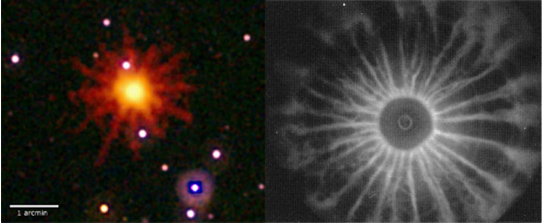
Left: Gamma Ray Burst (GRB) 110328A. Right: Plasma focus penumbra and filaments. Credit: (L) NASA/Swift/Stefan Immler. (R) Focus Fusion Society.
Oct 06, 2011
Converging radial filaments indicate an interstellar Birkeland current “pinching down” into an hourglass shape.
According to a recent press release, the longest lasting gamma-ray source ever recorded has been found by the Swift satellite’s Burst Alert Telescope. “Swift” is so named because it can quickly identify and transmit the coordinates of various celestial high energy sources, so that optical instruments can locate the associated visible object (if it exists).
The Hubble Space Telescope and the Chandra X-ray Observatory also participated in the discovery. Chandra’s image reveals the gamma-ray source is emitting copious X-rays in highly collimated beams.
The consensus opinion among astrophysicists who study these phenomena is that there is a supermassive black hole (SMBH) in the center of the galaxy in which the GRB was detected. Matter from the surrounding stellar neighborhood is said to be pulled into the SMBH, where it is accelerated by an intense gravity field. The extreme velocity supposedly heats up particles as they approach the speed of light. It is that excitation that is said to create X-rays and gamma-rays.
On the other hand, an electromagnetic z-pinch can squeeze plasma with such force that it rapidly compresses. Electric current flowing into the z-pinch might cause the plasma to erupt in an arc-mode discharge. We are seeing plasma structures when we look at nebulae, as well as the “remnants” of supernovae, and they behave according to the laws of electric discharges and circuits.
One of the signature phenomena in a dense plasma focus is the helical strands of energy that surround a powerfully radiating arc-mode discharge and a dark-current torus. The strands are helical magnetic fields that confine plasma. In the two images at the top of the page, the dense plasma focus on the right compares with the gamma-ray emissions from GRB110328A on the left.
It is not a black hole that is forming the structures around the GRB. Near the center of the Milky Way, and presumably in the centers of all galaxies, there is an abundance of electromagnetic energy. There might be 28 filamentary strands (or 56, or 49 or some other number discussed by Alfvén, Peratt, Thornhill, and others) in the penumbral cloud of stars and nebulae that have been energized by the plasma gun effect.
Birkeland currents enable electricity to move great distances through space in a manner analogous to power transmission lines on Earth. Plasma is compressed within the vortical filaments in long lines extending out from the galactic nucleus. Sometimes the “lines” are seen in galactic images as “bars” that spin at right angles to the current flowing out of the central bulge. It is in the most dense current flows where stars form. GRBs are not created by gravitational forces, but by the electric nature of the Universe and the way that moving plasma behaves in a magnetic field.
Stephen Smith












